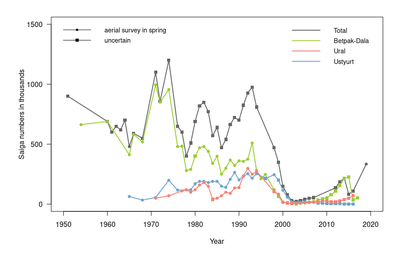Investigating long-term drivers of change in saiga populations (Saiga tatarica tatarica)
Julia Mari Murata
The critically endangered saiga antelope (Saiga tatarica L.) is a nomadic ungulate inhabiting the semi-arid rangelands of Central Asia, with four populations of the subspecies Saiga tatarica tatarica being found in Kazakhstan and Russia. In the past decades, the saiga population showed one of the most dramatic declines observed in mammal populations. With the focus on the saiga populations in Kazakhstan, this thesis investigated fluctuations in saiga numbers and related drivers of change from 1950 up to the present time.
I conducted a systematic literature review to examine findings on drivers of population declines, and collected data on population estimates from literature with a critical view to important events. In addition, I applied a Crisp-set Qualitative Comparative Analysis to selected literature in order to identify causal relationships between drivers and losses in the populations.
The results indicated that intense hunting strongly lowers the population size on a long-term scale, and especially the selective hunting of male saigas associated with poaching appears to be devastating. In this context, the dissolution of the Soviet Union in 1991 followed by a lack of management actions and an increase in poaching particularly affected the saiga. Furthermore, mass mortality events being linked to climate conditions and disease outbreaks tend to be a severe threat due to temporal proximity, and when saiga numbers are already on a low level. The further analysis showed that the causally independent assessment of drivers is likely to be insufficient to explain the documented population losses, and urges more investigation of the linkages between drivers of change from an interdisciplinary view.f protected areas, it is recommended to take efforts to secure their sustainability.

Bannikow (1963), Beauvais et al. (2019), Bekenov et al. (1998), SCA (2008), Fry (2004), IUCN (2018), Knight (2019), Kock et al. (2018), Milner-Gulland (1994), Milner-Gulland et al. (2001), Sokolov (1974), Orynbayev et al. (2016), Williams (2016) and FZS (2011).
